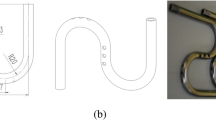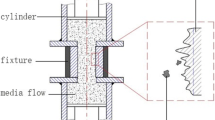Abstract
The quality of the inner surface of the elbow used by common types of engines has a serious impact on its performance. In order to improve the machining accuracy of the inner surface and enhance the uniformity of the whole structure, large eddy simulation is carried out for the flow channel in an S-shaped elbow with the abrasive flow by using KET subgrid model. The distribution of flow field, vortex formation law, and the influence of the vortex in the process of polishing surface quality are analyzed, and the processing experiment is carried out. The numerical simulation result shows the inlet pressure determines the inlet velocity of abrasive particle flow. Higher inlet pressure will significantly increase the shear force, improve the uniformity of turbulence kinetic energy distribution on the elbow wall, and increase the number of abrasive flow vortices. The experiment result shows the changes in inlet pressure and abrasive particle size have a significant effect of the polishing effect on S-shaped elbow. The combination of coarse abrasive and high inlet pressure will produce an over-polishing phenomenon, the inner surface roughness of the elbow can be reduced to 76 nm, and the optimal process parameters determined by the experimental research can achieve the uniform polishing of the S-shaped elbow by the abrasive flow machining technology.















Similar content being viewed by others
References
Yuan X, Tao Z, Li HW, Tian YT (2016) Experimental investigation of surface roughness effects on flow behavior and heat transfer characteristics for circular microchannels. Chin J Aeronaut 29(6):1575–1581. https://doi.org/10.1016/j.cja.2016.10.006
Chen Y, Li LB, Zeng JH, Kang L, Han B (2018) Experimental study on precision grinding of titanium alloy conduit inner surface in aero-engine. Aeronaut Manuf Technol 61(9):40–46. https://doi.org/10.16080/j.issn1671-833x.2018.09.040 (Chinese)
Fu YZ, Gao H, Yan QS, Wang XP, Wang X (2020) Rheological characterisation of abrasive media and finishing behaviours in abrasive flow machining. Int J Adv Manuf Technol 107:3569–3580. https://doi.org/10.1007/s00170-020-05288-9
Duval-Chaneac MS, Han S, Claudin C, Salvatore F, Bajolet J, Rech J (2018) Experimental study on finishing of internal laser melting (SLM) surface with abrasive flow machining (AFM). Precis Eng 54:1–6. https://doi.org/10.1016/j.precisioneng.2018.03.006
Jung D, Wang WL, Knafl A, Jacobs TJ, Hu SJ, Assanis DN (2008) Experimental investigation of abrasive flow machining effects on injector nozzle geometries, engine performance, and emissions in a di diesel engine. Int J Automot Technol 9(1):9–15. https://doi.org/10.1007/s12239-008-0002-0
Sambharia J, Mali HS (2017) Recent developments in abrasive flow finishing process: a review of current research and future prospects. Proc Inst Mech Eng B J Eng Manuf 233(2):388–399. https://doi.org/10.1177/0954405417731466
Kumar SS, Hiremath SS (2016) A review on abrasive flow machining (AFM). Procedia Technol 25:1297–1304. https://doi.org/10.1016/j.protcy.2016.08.224
Wang AC, Cheng KC, Chen KY, Lin YC (2018) A study on the abrasive gels and the application of abrasive flow machining in complex-hole polishing. Procedia Cirp 68:523–528. https://doi.org/10.1016/j.procir.2017.12.107
Han S, Salvatore F, Rech J, Bajolet J (2020) Abrasive flow machining (AFM) finishing of conformal cooling channels created by selective laser melting (SLM). Precis Eng 64:20–33. https://doi.org/10.1016/j.precisioneng.2020.03.006
Han S, Salvatore F, Rech J, Bajolet J, Courbon J (2020) Surface integrity in abrasive flow machining (AFM) of internal channels created by selective laser melting (SLM) in different building directions. Procedia CIRP 87:315–320. https://doi.org/10.1016/j.procir.2020.02.022
Petare AC, Jain NK (2018) A critical review of past research and advances in abrasive flow finishing process. Int J Adv Manuf Technol 97:741–782. https://doi.org/10.1007/s00170-018-1928-7
Singh P, Singh L, Singh S (2020) Analyzing process parameters for finishing of small holes using magnetically assisted abrasive flow machining process. J Bio- Tribo- Corros 6(1):1–10. https://doi.org/10.1007/s40735-019-0315-8
Kumar SS, Hiremath SS (2020) Surface topography and wettability of the metallic surface machined through abrasive flow finishing. Adv Mater Process Technol 6(1):115–132. https://doi.org/10.1080/2374068X.2019.1709308
Li JY, Zhang HF, Wei LL, Zhang XM, Xu Y, Xu CY (2019) Formation mechanism and quality control technology for abrasive flow precision polishing vortex: large eddy simulation. Int J Adv Manuf Technol 105:2135–2150. https://doi.org/10.1007/s00170-019-04232-w
Li J, Zhang H, Wei L, Liu Y, Zhang X, Zhao W (2020) Quality prediction and discussion of an abrasive flow precision polishing baffle servo valve nozzle based on orthogonal experiments. JOM 72:3236–3246. https://doi.org/10.1007/s11837-020-04219-z
Li JY, Zhu JB, Zhang HF et al (2021) Vortex formation mechanism and experimental research of abrasive flow precision machining special inner curved surface based on large eddy simulation. Int J Adv Manuf Technol 116(5–6):1633–1651. https://doi.org/10.1007/S00170-021-07537-X
Nagalingam AP, Yuvaraj HK, Santhanam V, Yeo SH (2020) Multiphase hydrodynamic flow finishing for surface integrity enhancement of additive manufactured internal channels. J Mater Process Technol 283:116692. https://doi.org/10.1016/j.jmatprotec.2020.116692
Singh S, Kumar D, Sankar MR, Jain VK (2019) Viscoelastic medium modeling and surface roughness simulation of microholes finished by abrasive flow finishing process. Int J Adv Manuf Technol 100:1165–1182. https://doi.org/10.1007/s00170-018-1912-2
Singh S, Raj ASA, Sankar MR, Jain VK (2016) Finishing force analysis and simulation of nanosurface roughness in abrasive flow finishing process using medium rheological properties. Int J Adv Manuf Technol 85(9–12):2163–2178. https://doi.org/10.1007/s00170-015-8333-2
Acharya S, Tyagi M, Hoda A (2001) Flow and heat transfer predictions for film cooling. Ann NY Acad Sci 934(1):110–125. https://doi.org/10.1111/j.1749-6632.2001.tb05846.x
Majander P, Siikonen T (2006) Large-eddy simulation of a round jet in a cross-flow. Int J Heat Fluid Flow 27(3):402–415. https://doi.org/10.1016/j.ijheatfluidflow.2006.01.004
Yang KS, Ferzigert JH (1993) Large-eddy simulation of turbulent obstacle flow using a dynamic subgrid-scale model. AIAA J 31(8):1406–1413. https://doi.org/10.2514/3.49081
Yang ZY (2015) Large-eddy simulation: past, present and the future. Chin J Aeronaut 28(1):11–24. https://doi.org/10.1016/j.cja.2014.12.007
Kim WW, Menon S, Kim WW, Menon S (1997) Application of the localized dynamic subgrid-scale model to turbulent wall-bounded flows. In: 35th aerospace sciences meeting and exhibit, p 210. https://doi.org/10.2514/6.1997-210
Funding
The authors receive funding support from the National Natural Science Foundation of China Nos. NSFC 51206011 and U1937201, Jilin Province Science and Technology Development Program of Jilin Province No. 20200301040RQ, Project of Education Department of Jilin Province No. JJKH20190541KJ, and Changchun Science and Technology Program of Changchun City No. 18DY017.
Author information
Authors and Affiliations
Contributions
Junye Li designed and performed the manuscript, analyzed the data, and drafted the manuscript. Tuo Sui and Hui Lu analyzed the data and supervised this study. Huawen Zhou and Jinbao Zhu conceived the project, and Jianhe Liu and Jinzhe Li organized the paper and edited the manuscript. All authors read and approved the manuscript.
Corresponding author
Ethics declarations
Ethical approval
Not applicable.
Consent to participate
Not applicable.
Consent to publication
All presentations of case reports have consent for publication.
Conflict of interest
The authors declare no competing interests.
Additional information
Publisher's Note
Springer Nature remains neutral with regard to jurisdictional claims in published maps and institutional affiliations.
Rights and permissions
About this article
Cite this article
Li, J., Sui, T., Lu, H. et al. Surface quality control technology of abrasive flow polishing S-shaped elbow. Int J Adv Manuf Technol 121, 683–699 (2022). https://doi.org/10.1007/s00170-022-09353-3
Received:
Accepted:
Published:
Issue Date:
DOI: https://doi.org/10.1007/s00170-022-09353-3




